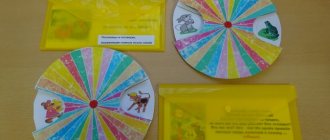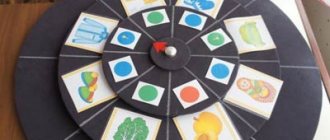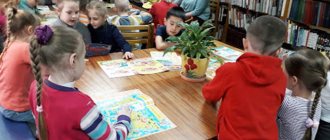How does cognitive interest arise in preschoolers?
Cognitive interest is not formed out of nowhere or at the will of parents. It appears when a child encounters something completely new that does not fit into the “matrix” of his knowledge and experience. Surprise and puzzlement appear. The riddle haunts the preschooler until he clears up the keys to the answer.
Example. Deniska, 3.5 years old, saw a small tractor with a body in front. The first thing the kid asked was: “Why is the tractor driving backwards?” After listening to the answer, he walked a few steps backwards, just in case. Then came the conclusion: “So the driver sees that he is lucky.”
The child saw a flower bloom on the windowsill, and he is ready to water the indoor plants every day to repeat the phenomenon. He watches his grandmother knead the dough, and he certainly wants to practice turning loose flour into plastic dough.
The preschooler wants to join activities that awaken emotions and experiences. Even putting together puzzles and construction sets gets the child interested in the fact that the result should be a beautiful picture or model.
Some objects and phenomena captivate the child for a short time, others hold attention for a long time. The main forms of expression of interest can be identified:
- Curiosity is a primary interest in a subject, object or event.
- Curiosity is the desire to study a subject in more detail, to find its still hidden properties. At this stage, the joy of learning new things is formed. Research is carried out using trial methods or questions.
- Direct cognitive interest is characterized by the emergence of a task or situation in which the child seeks to understand independently, to understand the true essence of the phenomenon. At this stage, the mechanisms are dismantled into individual screws or the doll is disassembled into its components to find out what’s inside.
What maintains cognitive interest in preschool age
Cognitive interest can easily fade away if it is not nourished. Adults play a certain role here, encouraging the child to continue, but the main factors that stimulate continuation are cognitive independence and the presence of motivation.
In the process of learning something new, there is a combination of feelings and the intellectual component. A preschooler feels a sense of admiration when he learns that the seasons in the southern hemisphere follow different principles.
The joy of learning new things causes impatience and complete fascination with a toy or book that contains new information. Dismantling an alarm clock or kitchen appliances provokes such excitement that the young explorer may not notice his parents watching him.
Small experiments that can be carried out with the help of numerous sets of young physicists and chemists make you freeze in anticipation of the result. And finally, nothing motivates you to continue learning more than a solution achieved on your own.
Cognitive independence
Starting from the age of five, a preschooler increasingly asks chains of clarifying questions. He becomes interested in a specific subject or process, asks the main question that worries him, but the answer he receives prompts him to further research and new questions.
The essence of cognitive independence lies in the fact that the child himself, without additional incentives, feels ready to acquire new knowledge.
Older preschoolers can express their disagreement with the answer, offer their own version and persistently find out where their assumption is wrong. If it is necessary to obtain additional information, preschoolers themselves initiate a conversation with an adult and ask questions, filling in gaps in their knowledge.
One of the main conditions for the manifestation of cognitive independence is the sufficient development of the volitional sphere. When solving a task set for yourself, you need to finish the job, even if you encounter obstacles: screws don’t unscrew, parts don’t fit together, you can’t draw as your imagination suggests.
Cognitive motivation
Motivation is the second pillar on which cognitive interest stands. An adult’s verbal offer to assemble a model or read a book is not valid. It is necessary that the child is passionate about the process himself and strives to continue or begin the study.
The formation of cognitive motivation in preschool children is closely related to the development of voluntary attention.
A task that previously intrigued a child may turn out to be quite difficult for him. To continue to solve it, you need to maintain attention and remember the goal. This is beyond the power of younger preschoolers who have not yet learned to manage their attention.
Psychologists identify the conditions necessary for the formation of cognitive motivation of a preschooler:
- Emotional support. A child retains attention and interest in a task longer if he is encouraged, praised, and supported.
- Activation of thought processes. Minor hints for the child, an offer to check another version, inspires the young researcher. He comes up with an immediate goal and ideas on how to achieve it.
- Discussing successes and failures, encouraging the child to independently find explanations for why it was or was not possible to find a solution.
Cultivating curiosity gives rise to the independent habit of looking for everything unknown and incomprehensible in the surrounding space. Learning new things becomes a need for a child and motivates him to take cognitive actions, be it learning to read or compiling a collection.
Bibliography
- Ivanenko S.F., Formation of speech perception in children with severe speech impairment. M., 2004.
- Markova L.S. Organization of correctional and developmental education for preschoolers with mental retardation. Practical guide. – M, 2005
- Federal State Educational Standard for Preschool Education, 2013.
- Khudenko E.D., Melnikova T.S., Shakhovskaya S.N. How to teach a child to think and speak? // NPF "Uniserv". – M.: 1993. – 172 p.
- Shevchenko S.G. Preparing children with mental retardation for school. Book 1 / Generally ed. S.G. Shevchenko. – M.: School Press, 2003. – 96 p.
Development of cognitive interests in older preschoolers
In older preschool age, the relationship between cognitive interest and attention increases significantly. During this period, children realize that the correct result largely depends on how carefully all the details were taken into account.
The arbitrariness of the attention function is also formed; children are able to concentrate on a task without being distracted by foreign objects or situations.
The progressive development of cognitive processes leads to the fact that older children analyze more, learn to highlight the main thing and abstract from unimportant signs. On the one hand, they are more capable of finding answers to their questions, but, on the other hand, their cognitive interests cover more areas.
At this stage, a cognitive interest in mathematics is formed. Preschoolers are interested in performing simple arithmetic operations, measuring objects, and solving logic problems.
Search and experimental activities play a significant role in the development of cognitive activity. The child is an experimenter. Understanding the world through experience is its natural state. In addition, the result obtained as part of the experiment is assimilated much better than just an adult’s story.
During the experiment, the older preschooler, on his own, receives answers to questions that are significant at his age: “How?” and why?". You can tell your child all you want about the laws of aerodynamics, but he won’t understand what you’re talking about until he flies a kite.
On walks or excursions, children get the opportunity to constantly experiment: why a leaf floats down a stream, why snow melts; see that the plucked branch will dry out or, conversely, take root in a glass of water.
In essence, cognitive research activities are close to experiments. It involves experimentation, but also uses collecting to teach how to classify objects according to various characteristics. You can collect herbariums and stamps, as well as figurines from the robot collection.
Excursions help you explore a piece of space along which the route is laid. Educational activities consist of acquiring minimal cartography skills, studying the plants and habits of animals encountered along the way.
The role of an adult in the formation of cognitive interest of preschool children
The main task of adults at the stage of formation of cognitive interest is to maintain the motivation of a preschooler and use methods that help keep children’s attention and complete the task.
Parents need to make sure not only that there are reference books and encyclopedias suitable for preschool age in the house, but also regularly read with their child materials that enrich the child’s knowledge. It is useful to use non-standard developmental methods. For example, finger games for children are exciting in their practical implementation and bring tangible benefits to the development of fine motor skills.
The main lines of work in the development of children's cognitive interest:
- Supporting the child's desire to ask questions. Expressed in a favorable attitude and detailed explanation instead of short answers and excuses.
- Additional stimulation of cognitive interest. It consists of exciting stories, identifying topics that interest the preschooler, expanding answers, going beyond the topic. For example, when talking about hours and minutes, you can touch on the calendar.
- Application of games. For preschoolers, this is the main activity in which new skills are learned. You can build games in the form of “question-answer” or correct information that the child uses incorrectly when playing with peers.
- Supporting a preschooler in his research. Praise upon achievement of a result and during the activity so that the child understands that his efforts aimed at solving the problem are important.
- Help in mastering planning and goal setting skills.
Adult support for a child's curiosity in relation to any area of life will lead to the presence of developed cognitive interest. And this is a good deposit for upcoming school success and diversified personality development at any age stage.
Curiosity exercises and games
Games and play exercises have always been a good help for homeschooling. They will help in developing curiosity and cognitive interest. The main thing when choosing such games is that they should encourage children to explore, evoke a desire to learn new things and get to the bottom of things.
Chain of questions
The exercise can be done in any situation: at home, on a walk, in a home lesson. An adult comes up with an interesting topic, for example, “Why do you need clothes?”, “Why does it rain?”, “Where do mushrooms come from?” Initially, questions are asked by an adult to teach the child to build a logical chain of questions, and then the child can ask questions. The preschooler answers the questions until he can find the answer. The adult helps him with guiding sentences or, if there is difficulty, answers the question himself. For example, the logical chain could be like this:
- why do you need clothes?
- what kind of clothes are there?
- Without clothes, what would a person be like?
- What are clothes made from?
- When there was no fabric, what did people wear?
- How did they get the skins?
- How can you make clothes from skins?
Transforming old into new
The easiest way to improve children's curiosity is to come up with new uses for old objects. For example, a mother collects all the unnecessary things in the kitchen (boxes, plastic bottles, glasses, lids) and invites the baby to figure out how to use them again in everyday life. From small plastic bottles you can make funny animal faces if you glue ears to them and draw eyes, noses, and antennae; By covering an old box with beautiful fabric, you can get an original box as a gift for your grandmother. The main thing is to encourage the child to come up with various transformations himself, to see the perspective of the old thing.
Games - excavations
Nowadays such games are becoming popular for children and adults, so by purchasing a game - excavation, it can be made into family entertainment. Excavation games are aimed at developing curiosity, for example, “Secrets of the Pyramids”, “Young Archaeologist”, “Dinosaur in the Iceberg” or “Lost Expedition”. Then you can make similar games yourself and play for quite a long time. The point of all games is that you must unearth some artifact under the cultural layers. Game actions help to discover ancient secrets of history. At family leisure, it is interesting to organize a competition to see who can get to the bottom of an artifact the fastest or suggest collecting artifacts.
Traveling in time
There are different versions of such travel games that you can play with your children. They help not only develop the child’s cognitive interests, but also teach logical thinking.
- Online game: according to the plot, the hero finds a time machine, but cannot control it. Without studying the instructions, he simply presses the button and begins to travel. As a result, he will meet many interesting characters from different historical times: dinosaurs, knights, cowboys. The hero of the game will face different trials in different historical times. We need to help him return to modern times.
- The verbal logic game begins with the presenter’s story: “In one country, each resident had his own time machine. Residents used it in different ways: some traveled only to the past, others only to the future. But there were inhabitants in this country who did not travel and lived at the present time. Because of this, the cars rusted. Tim lived in this country, he was very curious, but his family only flew into the past. And he really wanted to go to the future. And one day he made his way to the time machine, lubricated all the mechanisms, and the machine took him to the future. After returning, curious Tim told all the residents how wonderful the future was. And everyone wanted to fly there. But the time machines only moved where they were used to flying. Many residents didn’t even try, but some still learned how to control a time machine and fly where they want.” Players must tell where they will go and what they might encounter on their journey, for example, in the past tense - dinosaurs, cave dwellers, knights, kings and queens. Or in the future - robots, interplanetary spaceships. To maintain interest and implement the idea, you can invite the child to make a sketch, and the other participants in the game to guess what time the player visited.
"I am in the mirror"
The exercise helps to improve the cognitive interest of preschoolers, embody creative ideas, and verbally describe their emotional manifestations. The adult invites the child to draw himself in three mirrors: blue - I am in the present, green - I am in the past and red - I am in the future. Then there is a discussion of the drawings, for example, you can ask the preschool child what he felt when drawing, what emotions the image of himself in the past, present, and future evoked in him. Ask in what time it was easier to portray yourself? Be sure to collect all the drawings in a separate folder and return periodically to this topic in order to track how the desire to know yourself and imagine yourself in the future improves and becomes more active.
Such simple games and exercises that can be constantly present in children’s lives, as well as all other ways, will help parents raise an inquisitive, inquisitive child. Good luck in raising preschoolers!







